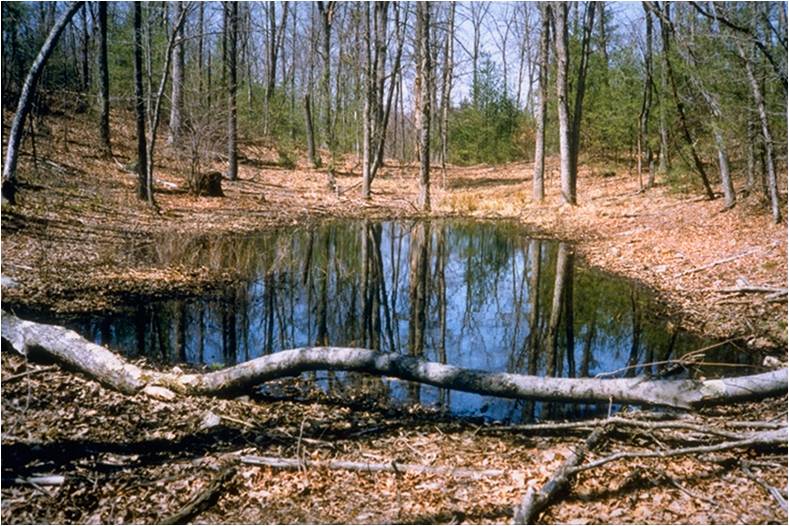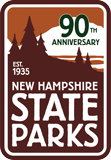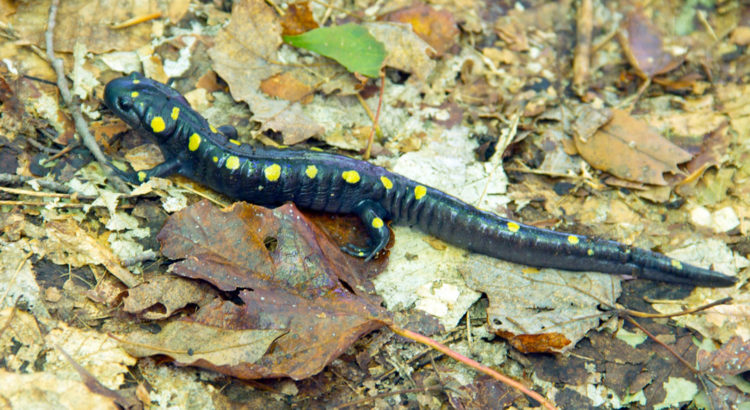By: Rand Michaels – Student Conservation Association’s NH AmeriCorps Member
To briefly paint a picture of life here at Bear Brook State Park in late March; the mud season has begun. Our snow drifts, which once ominously encroached on both sides of the one-way road to camp, have dwindled to a patchy collection of blanks in the brown landscape. The walk from the lodge to our cabins is peppered with pothole-puddles; pedestrians and vehicles alike, beware. Overhead, one of the many local pedestrians who pay attention to such things can hear a new bird every morning, as more and more have returned to our corner of the continent. In a great, atmospheric game of roulette, precipitation is just as likely to mean rain as snow. Darkness is slowly releasing its hold on the evening, and in the process, allowing more and more time for after-work exploration of the park each week. Soon, the snow will be gone entirely and this thawed ground will prompt one of the most magical and all too-often invisible wonders of temperate forests in spring.

Such events called “Big Nights” are characterized by hundreds or thousands of freshly active, slimy animals crawling their slow way towards vernal pools. These animals are mostly frogs and salamanders who have been inactive all winter. For frogs I mean inactive like their hearts were stopped, and their entire bodies, save some intercellular spaces were frozen solid beneath the snow. They accomplish this uniquely amphibian feat by increasing the sugar content within most of their cells, making them unlikely to freeze even when subjected to the coldest temperatures of a New Hampshire winter. Their motivation as soon as they wake up from this strange slumber is to move to a vernal pool in order to find a mate. These pools (vernal coming from the Latin “vernus” meaning “spring”) are ephemeral, often drying up well before the dog days of summer. This is the characteristic which draws these creatures to lay their eggs here rather than a larger, more permanent body of water. Seasonal drying prevents fish from making their home in these pools, and making the eggs of our friends the amphibians into fish food.

The road to this great mire of mating is often fraught with danger for these groggy frogs and salamanders. Anyone who has played the game “Frogger” is familiar with the danger I mean, namely, crossing busy roads. When a road or highway happens to fall in between the winter resting place of these animals and their spring meetup, many of them fall prey to tires on their journey across the tarmac. This is the main drive for the Salamander Crossing Brigade project, coordinated by Brett Amy Thelen of the Harris Center for Conservation Education. This project, just as one might imagine upon hearing its name, involves teams of volunteers who actively move amphibians from one side of the road to the other in order to save them from becoming casualties of traffic. These volunteers, donning reflective vests and headlamps and armed with species checklists, head out on rainy spring nights (those most likely to become “Big Nights”) and keep count of the species of each individual they move safely across the road. Since 2006, these ‘Salamander Crossing Brigades’ have moved over 35,000 individuals to safety across roads in the Monadnock Region of Southern New Hampshire.
Obviously, as admirable as this hands-on approach is to saving these individuals, it is not a sustainable solution to the danger that roads pose to amphibians. A much more ideal solution is to close these stretches of road entirely on Big Nights. It is because of data collected by these Crossing Brigade volunteers that the City of Keene has decided to do just that for a section of North Lincoln Street this spring. While this decision, the first of its kind in New Hampshire, is a big win for local amphibians, hundreds more crossings are still in need of help, and likely hundreds more are in need of discovery. If you are wondering how you can join one of these heroic brigades, please head to the The Harris Center For Conservation Education’s website for more information.
If you like to spend your nights searching for nature’s miracles, like I do, please head out this spring and search for these amphibians and their vernal pools. Whether that is in the woods of a state park like Bear Brook or the road in front of your house, have fun and I hope to see you there!

